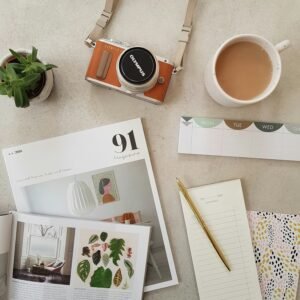Creating a Digital Portfolio That Gets Noticed

A robust web presence is necessary in order to thrive in this rapidly moving, very visual art community. Your website must have a strong message of who you are, what you do, and why you’re hireable or worth working with, whether you’re looking for a full-time job, trying to drum up freelance work, or just primping online.
But since there are so many artists who show their art on the internet, how do you get noticed online above all else?
In this lesson, we will break down how to make an awesome portfolio and then also an effective one. We will also determine how your graphic design portfolio, UX design portfolio, motion graphics examples, etc., can be strategically used to showcase your style as well as scope.
Why A Strong Digital Portfolio Is Important
A successful online portfolio
• Serves as a personal brand ambassador
• Acts as evidence of your proficiency and flexibility
• Emphasizes your problem-solving capabilities
• Opens doors to enhanced projects, clients, and careers
• Showcases professionalism and design process
No matter if you’re pitching freelance design projects, interviewing for studio jobs, or pitching to an agency, your first introduction—and quite often your only one—is likely to be your portfolio.
Step 1: Curate, Don’t Dump
One of the biggest mistakes creatives are guilty of is trying to include everything that they’ve ever done. Use the best, most applicable work instead. Use the appropriate material for the situation that you are applying for.
For example:
• If you are targeting the tech startups, feature your UX design portfolio and UI design showcase
• For branding companies, prioritize branding examples and concept designs for logos initially
• If you are an animation specialist, highlight your motion graphics examples
Quality matters more than quantity—our preference is for 6 to 10 outstanding projects over 30 average ones.
Step 2: Depict the Process
Employers and customers enjoy seeing the way you think. Describe briefly how you are creative.
- The challenge or brief
- The procedure (research, sketches, revisions)
- The result
For example, a concept for a logo may progress from the first pencil drawings to the final vector logo. Likewise, a web design gallery project may include wireframes, mockups, and live previews.
The narrative voice brings sincerity and richness to your body of creative writing.
Step 3: Expand to Multiple Mediums
Your online portfolio can—and ought to—contain various types of work. This is going to keep the viewers interested, but also show that you are versatile.
Consider adding:
• Interactive prototypes (ideal for UX design demonstration)
• Looping or animated intros (motion graphics loops)
• Scrollable galleries (illustration portfolio, web design gallery)
• Printable offline pdfs for reading
• Case studies with videos, slides, or gifs
Being multi-format capable demonstrates your expertise across tools and technology—a definite advantage in today’s online world.
Step 4: Align with Your Personal Brand
Every element of your online presence, from the typeface to the colors—ought to communicate your business or personal brand.
Ask yourself:
- Is this design aesthetic consistent?
- Is the tone of my writing consistent with the way I talk and how I portray myself?
- Are my visuals reflective of my vision and values?
No matter how much you enjoy minimalism or graphics, every part of your design structure needs to have coherence and meaning.
Step 5: Navigation Should Be Intuitive
No matter how good-looking your site is, poor UX will drive people away. Well-organized, consistent visual hierarchy keeps the user interested.
Navigational cues:
• Organize your projects according to their respective categories, i.e., branding samples, examples of UI design, etc.
• Use bold call-to-action buttons like “View Case Study,” “See More,” etc.
• Provide mobile responsiveness
• Offer filtering or tagging capabilities for easier discovery
Think of your online portfolio as a project in itself—a piece of work that should be as well-designed as the work it presents.
Step 6: Add Real-World Applications
Design resolves issues. Depict how your designs operate in real life.
Examples:
• Branding mock-ups on signage or packaging
• Desktop or mobile frames with embedded user interface screens
• App walkthrough animated user interfaces
• Posters, brochures, or social media entries that feature your typography
Visual context also makes your graphic design portfolio more relatable and helps potential clients to picture your work for their brand.
Step 7: Highlight Key Projects
Every portfolio has showstopper pieces—pieces that capture the attention, convey a narrative, and embody your entire body of knowledge.
A successful hero project should include:
• Samples of logos + branding
• A mobile or website tour of your UX design portfolio
• A full identity system done in a portfolio style with creativity
• A Cross-Platform Design for Your Freelance Design Business
Use the graphics, headlines, and callouts to lead the viewer’s gaze and show them your best material.
Step 8: Add Testimonials and Background
Want to establish trust quickly? Have other people speak for you.
Include short testimonials from:
• Clients
• Professors or mentors
Bring this all together with some background: Who was the project for? What was the goal? What specific way did your participation have an impact?
The added dimension gives a more human, authoritative, and impactful presence to your online portfolio.
Step 9: Remain Up to Date
An out-of-date portfolio is a missed opportunity. Refresh it from time to time with new visual design samples, client projects, or personal projects of interest.
Even some creatives include design challenges on a daily basis—adding unique items to their illustration portfolio, typography portfolio, or digital artwork gallery.
Exhibit that you are proactive, curious, and continually developing.
Step 10: Link It Everywhere
Your online portfolio does not exist in a vacuum. Link it:
• On your LinkedIn profile
• In your signature line
• Through social media bios
• On resumes and cover letters
Also check for platforms like Behance, Dribbble, or your site or website for further coverage.
Final Thoughts
In the competitive creative market, the best tool you have is your online portfolio. It is not just a visual collection of images but is symbolic of your voice, narrative, and devotion to clients and collaborators.
Whether you are presenting a graphic design portfolio, developing a sleek UX design portfolio, or developing an enthusiastic creative design portfolio, approach your digital portfolio with strategy, thought, and creativity.
Recall: good isn’t always about how well you perform—it’s about getting noticed.
Share:
More Posts

How to Get Started with Concept Art
Anyone who ever marveled at intricate video game worlds, fantasy animated superheroes, and sci-fi film space ships must have been exposed to concept art. Concept

Best Free Online Galleries for Artists
Every artist today must possess a strong web presence. Having an exhibition featured in an online art gallery is among the best methods through which

What Makes a Great Creative Blog?
In the fast-changing world of design, art, and digital imagination today, a creative blog is not a hobbyist pursuit—it’s a tool for self-expression, career development,

Daily Art Prompts to Spark Creativity
All creatives are guilty of that terrible moment of standing before the blank canvas, the blank sketchbook, or the blank screen with no idea where

